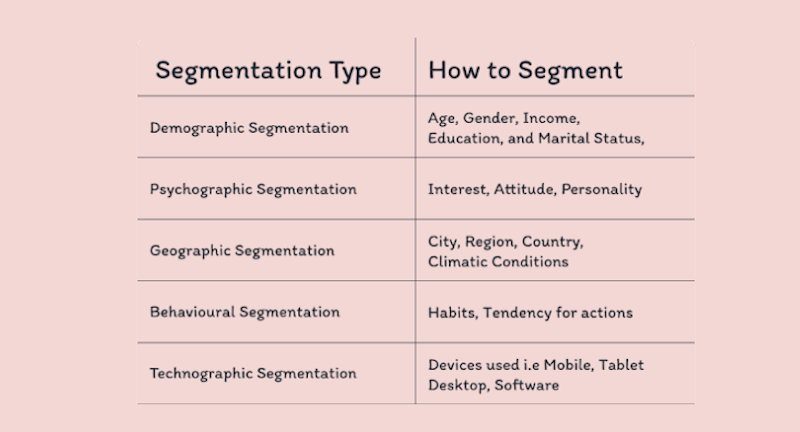User Segments and Their Role in Business
In a world where customers are diverse and ever-changing, user segmentation provides the roadmap for businesses to navigate the intricacies of their target audience. Clearly understanding your target audience is crucial for success, especially in today's global business landscape and often broad user base. User segmentation isn't just a fancy term; it's a game-changer for business and marketing. When you really get what makes each user group tick, you can make marketing magic happen, keep customers happy, and watch your business grow.
Companies can tailor their marketing efforts, enhance customer satisfaction, and develop innovative strategies to drive growth by employing effective user segmentation practices. In this article, we examine user segments, their role in business and marketing, best practices for creating effective segments, and common mistakes to avoid.
What Are User Segments?

User segments are like clubs of customers who share similar traits and behaviors. By sorting customers into these groups, businesses can get to know their customers better and understand what they want and why. This knowledge helps companies tailor their marketing, products, and services to each group instead of trying to appeal to everyone at once, ultimately increasing sales.
For example, a business might segment its customers based on age, gender, location, or interests. This would allow the business to target its marketing campaigns more effectively and ensure that its products and services are relevant to the people who are most likely to be interested in them. Another example is an online clothing store with user sections for men's fashion, women's fashion, children's clothing, and maybe outdoor enthusiasts. This allows them to tailor their marketing, products, and promotions to each group's preferences.
User segmentation can also be used to improve customer service. By understanding the needs of each group, businesses can provide better support and resolve issues more quickly. Overall, user segmentation is a powerful tool that can help businesses improve their marketing, products, services, and customer service.
The Role of User Segments in Business and Marketing
User segmentation is a strong strategy that may help organizations of all sizes prosper. It enables businesses to understand their users better, customize their marketing efforts, and make more insightful decisions. Some of the ways that user segmentation might help businesses include:
Understanding Customer Diversity
In the world of consumers, every customer is unique. They have diverse backgrounds, preferences, behaviors, and motivations. User segmentation acknowledges this diversity and seeks to categorize customers into distinct groups based on common characteristics or behaviors. This grouping makes it easier for businesses to understand and deal with their customers.
Making Marketing Personal and Precise
After splitting customers into groups, businesses can tweak their marketing to fit each group's special wants and likes. This personal touch is a big deal in marketing because it lets companies create messages, deals, and products that click with each group.
The result? More people get interested, more people buy, and the whole marketing machine works better.
Smart Use of Resources
User segmentation helps businesses use their resources better. By figuring out which groups are the most valuable and responsive, companies can put their marketing money and effort where it matters most. Instead of trying to please everyone at once, they can concentrate on the groups that bring in the most money. It's like making every dollar count and getting the most out of what you spend.
Better Products with Customer Insights
User segmentation isn't just about marketing; it also helps create better products. Businesses can design and improve products that suit specific customer groups by looking at what different groups like, need, and find challenging. This means products are more likely to match customers' wants, making them more likely to succeed in the market. It's like designing a puzzle piece that fits perfectly into a particular group's needs.
Data-Driven Decision-Making
User segmentation isn't guesswork; it's based on data. It uses lots of information about customers, like who they are and what they do, from demographics to behavior and more. This data-driven approach lets businesses make decisions backed by facts. It lowers the chances of making expensive marketing mistakes and keeps businesses flexible when customers change their preferences.
Customer Retention and Loyalty
When a business gets what a customer wants, they're likely to stick around. User segmentation makes customers feel understood, and this makes them happy and loyal. Loyal customers often bring in a lot of money for a company and can even become fans who help the business grow.
Types of User Segments
User segments come in various forms based on the data used to segment them.

Although this table doesn't cover every customer segment, this should be a good starting point.
- Demographic Segmentation: This groups customers based on things you can see, like age, gender, income, education, and marital status.
- Psychographic Segmentation: This digs deeper than demographics and looks at things like what customers like, value, and believe in. It's understanding what makes them tick and why they do what they do.
- Geographic Segmentation: This focuses on customers' location, whether it's by city, region, or even climatic conditions. It helps businesses customize their products and messages to match where customers are.
- Behavioral Segmentation: This is all about what customers do, like what they buy, how loyal they are to a brand, and their habits. It helps businesses figure out what customers might do in the future and how to market to them effectively.
Benefits of Effective User Segments

User segments play a crucial role in shaping businesses and marketing strategies. They help businesses:
- Target Better: When businesses know which user group they're talking to, they can create messages that hit home. This means marketing is more effective, and it leads to more sales and profits.
- Understand Customers: User segments provide a treasure trove of insights into what customers like, how they act, and what they buy. By looking at different segments, companies can spot trends, predict what customers might want next, and make smarter business choices.
- Make Customers Happy: When businesses give each user group what they want, customers feel like they're understood. Happy customers stick around and become loyal. This loyalty is like having a bunch of friends who always come back to your store.
- Get Smarter: User segments help businesses figure out what kind of products to create and how to make their business even better. By knowing what different groups need and like, companies can come up with new ideas, improve old ones, and keep customers coming back for more. It's like having a GPS for business success.
Avoiding Common User Segmentation Pitfalls
User segmentation is a great tool, but watch out for these mistakes;
- Being too broad or too specific: Finding the right balance is key. Being too broad makes marketing less effective while being too specific limits who you can reach.
- Ignoring data problems: Using wrong or outdated data can mess up your segmentation. Regularly check your data to make sure it's accurate.
- Relying only on demographics: Don't put all your eggs in one basket. Demographics are important, but combining them with other data like interests and behavior gives you a better view of your segments.
- Forgetting to update: Customers change, and so should your segments. Make sure you keep up with what's new and refresh your segments regularly. It's like keeping your map up-to-date so you don't get lost.
Best Practices for Creating Effective User Segments
The following best practices should be followed by businesses when creating effective user segments:
- Mix up your data: Don't rely on just one source. Use data from different places like customer surveys, social media, and purchase history. This gives you a full picture of your segments and makes them more reliable.
- Make segments actionable: Ensure you can actually do something with your segments. Can you reach them? Do you have the tools and channels to connect with each group effectively?
- Focus on what matters: Base your segments on stuff that really matters for your business and what drives your customers. This could be things like what they buy, what they're into, or what they need. Segments should be meaningful.
- Keep them fresh: User segments should be flexible and adapt to changes in the market and customer behavior. Review and update them regularly to stay up-to-date. Look at new data, research trends, and stay in the know.
- Test and double-check: Before you go full throttle with your segments, test them out. Use A/B testing and focus groups, or get customer feedback to ensure they work. This way, you'll be sure your marketing hits the mark.
- Weave segments into your strategy: Don't isolate your segments; weave them into your overall marketing plan. Align your segments with your marketing goals and make sure your campaigns fit with each group. It's like putting all the pieces of a puzzle together to create a bigger picture.
Conclusion
User segmentation is not just a buzzword; it's a valuable way for businesses to improve their performance in today's diverse and competitive landscape. By having their customer base divided into distinct groups based on common traits and behaviors, businesses can understand their customers better and, more precisely, personalize marketing efforts with data-driven decisions. However, to harness the full potential of user segmentation, businesses must adhere to best practices and avoid common pitfalls.
Mixing up data sources, ensuring segments are actionable, focusing on meaningful criteria, keeping segments fresh, testing and refining them, and integrating them into the broader marketing strategy are essential steps for success. By following these guidelines, companies can truly unlock the magic of user segmentation and watch their business thrive and grow, one satisfied customer segment at a time.
If you're eager to explore user segmentation, consider signing up for a free ConfigCat account today and witness how ConfigCat can streamline and fortify your software release management. ConfigCat is a feature flag and configuration management service with a powerful dashboard designed to accelerate your software releases and segmentation strategy, created by developers for developers with ❤️.
You can keep up with ConfigCat on GitHub, LinkedIn, Facebook, and X.
